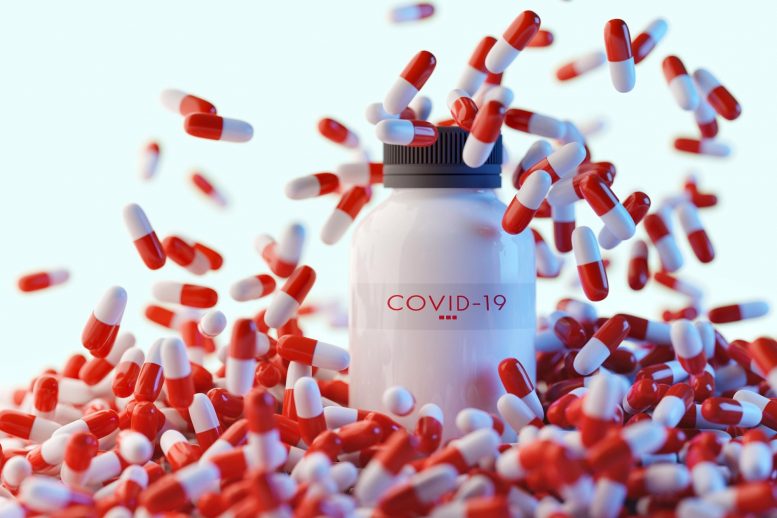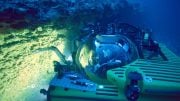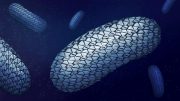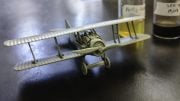
Scientists have identified nine potential COVID-19 treatments, three of which are already FDA-approved for other diseases.
Promising candidates include widely used transplant-rejection drug cyclosporine.
A team led by scientists in the Perelman School of Medicine at the University of Pennsylvania has identified nine potential new COVID-19 treatments, including three that are already approved by the Food and Drug Administration (FDA) for treating other diseases.
The team, whose findings were published in Cell Reports, screened thousands of existing drugs and drug-like molecules for their ability to inhibit the replication of the COVID-19-causing coronavirus, SARS-CoV-2. In contrast to many prior studies, the screens tested the molecules for anti-coronaviral activity in a variety of cell types, including human airway-lining cells that are similar to the ones principally affected in COVID-19.
Of the nine drugs found to reduce SARS-CoV-2 replication in respiratory cells, three already have FDA approval: the transplant-rejection drug cyclosporine, the cancer drug dacomitinib, and the antibiotic salinomycin. These could be rapidly tested in human volunteers and COVID-19 patients.
The experiments also shed light on key processes the coronavirus uses to infect different cells and found that the antiviral drug remdesivir, which has an FDA Emergency Use Authorization for treating COVID-19, does appear to work against the virus in cell-culture tests on respiratory cells, whereas hydroxychloroquine does not.
“Our discoveries here suggest new avenues for therapeutic interventions against COVID-19, and also underscore the importance of testing candidate drugs in respiratory cells,” said co-senior author Sara Cherry, PhD, a professor of Pathology and Laboratory Medicine and scientific director of the High-Throughput Screening (HTS) Core at Penn Medicine.
Study collaborators included co-senior authors David Schultz, PhD, technical director of the HTS Core, and Holly Ramage, PhD, assistant professor of microbiology & immunology at Thomas Jefferson University.
Although great progress has been made in the development of vaccines and treatments for the SARS-CoV-2 coronavirus, there is still much room for improvement. In the United States, the only antiviral COVID-19 treatments that have received FDA Emergency Use Authorization — remdesivir and several anti-SARS-CoV-2 antibody preparations — are expensive and far from 100 percent effective.
For their screening project, Cherry and colleagues assembled a library of 3,059 compounds, including about 1,000 FDA-approved drugs and more than 2,000 drug-like molecules that have shown activity against defined biological targets. They then tested all of these for their ability to significantly inhibit SARS-CoV-2 replication in infected cells, without causing much toxicity.
Initially, they performed antiviral screens using cell types they could grow easily in the lab and infect with SARS-CoV-2, namely African Green Monkey kidney cells, and a cell line derived from human liver cells. With these screens, they identified and validated several compounds that worked in the monkey kidney cells, and 23 that worked in the human liver cells. Hydroxychloroquine, which is used as a malaria drug, and remdesivir, were effective in both cell types.
Since SARS-CoV-2 is mainly a respiratory virus and is thought to initiate infections via airway-lining cells, the researchers sought a respiratory cell type that they could infect experimentally with the virus. They eventually identified a suitable cell line, Calu-3, that is derived from human airway-lining cells. They used these respiratory-derived cells to test the antiviral compounds identified through the human liver cell screen, and found that only nine had activity in the new cells. The nine did not include hydroxychloroquine. (Remdesivir worked in the Calu-3 cells but was not included in the list because it is already in use against COVID-19.)
By identifying different sets of drugs that work in different cell types, the researchers also shed light on the mechanisms SARS-CoV-2 uses to gain entry to cells. The findings suggest that in kidney and liver cells, the virus uses a mechanism that can be disrupted, for example, by hydroxychloroquine; yet the virus appears to use a different mechanism in respiratory cells, thus explaining hydroxychloroquine’s lack of success in those cells — and in COVID-19 clinical trials.
The nine antivirals active in respiratory cells did include salinomycin, a veterinary antibiotic that is also being investigated as an anticancer drug; the kinase enzyme inhibitor dacomitinib, an anticancer drug; bemcentinib, another kinase inhibitor now being tested against cancers; the antihistamine drug ebastine; and cyclosporine, an immune suppressing drug commonly used to prevent the immune rejection of transplanted organs.
The study highlights cyclosporine as particularly promising, as it appears to works against SARS-CoV-2 in respiratory and non-respiratory cells, and via two distinct mechanisms: inhibiting cell enzymes called cyclophilins, which the coronavirus hijacks to support itself, and suppressing the potentially lethal inflammation of severe COVID-19.
“There may be important benefits to the use of cyclosporine in hospitalized COVID-19 patients, and ongoing clinical trials at Penn and elsewhere are testing that hypothesis,” Cherry said.
Reference: “Drug repurposing screens reveal cell-type-specific entry pathways and FDA-approved drugs active against SARS-Cov-2” by Mark Dittmar, Jae Seung Lee, Kanupriya Whig, Elisha Segrist, Minghua Li, Brinda Kamalia, Lauren Castellana, Kasirajan Ayyanathan, Fabian L. Cardenas-Diaz, Edward E. Morrisey, Rachel Truitt, Wenli Yang, Kellie Jurado, Kirandeep Samby, Holly Ramage, David C. Schultz and Sara Cherry, 23 March 2021, Cell Reports.
DOI: 10.1016/j.celrep.2021.108959
The research was supported by funding from the National Institutes of Health (5R01AI140539, 1R01AI1502461, R01AI152362), the Mark Foundation, the Dean’s Innovation Fund, the Laddie and Linda Montague Foundation, the Burroughs Wellcome Fund, Mercatus, and the Bill and Melinda Gates Foundation.









please kindly send me news updates concerning physic, chemistry biology and mathematics
If you look at the sources of funding you see why ivermectin was omitted from this “study”. If your objective is to find a safe fda approved drug why look where approximately 20 countries and thousands of doctors have already gone. For actual science from people who are treating and curing covid go to flccc.
Too funny. You don’t even mention Leronlimab which was just shown in a phase III trial to reduce mortality in the critical population at day 14 by 82%!
Ivermectin is the single most efficacious drug against covid-19, but because it costs about 12cents per dose, the NIH and FDA, who are headed up now by pharmaceutical execs, have buried the data.
Loser partisan hack online paper… You just keep ignoring Ivermectin.. We see what all you big pharma shills are up to.
Zinc Citrate combined with HCQ or Quercetin should be exceptionally effective together with the ionaphore provided early enough to alter ph state so that zinc can activate and break up RNA strand activity via disruption of the protease enzyme, needed to replicate, but does not negatively impact mitochondria defense and does signal Tcells to the precise RNA distortion that targets other cytokines and RNA sections of the virus, thus ending transcription from cell RNA and offers the cell added reinforcement of cell, via signaling Beta cells to create interferon, ending all viral function. It should be noted that HCQ was ineffective by itself, because of the enzyme ACE2 that it blocked, when given early enough, but was NEVER STUDIED WITH ZINC Ions, thus rendering the studies a waste of money and time, because it never disrupted protease enzyme activity unless zinc ions were predominately present! You guys lost a huge opportunity to stop this early, but you never tested zinc ions in a positive ionaphore rich state. I just keep shaking my head… you just ignore really cheap solutions that work! Why didn’t you follow up on the work by that ER LA doctor that prescribed and administered hundreds of patients that same combination with dramatically reduced symptom and recovery outcomes? Look it up!
Please do not send me anything that has anything to do with the criminal Technocrats Bill and Melinda Gates.
No mention of Ivermectin? With our own eyes we see it works better than anything else and is dirt cheap. If covid is treated early (first few days) a full dose of Ivermectin provides a full “cure” usually in 24 hours! All symptoms gone! Can’t beat that and it has no side effects. Ivermectin has been in use 40+ years with no issues of significance. We take the preventive dose now for a year and have repeadly been exposed to Covid. If everyone took this it would be wiped out in one day! No Experimental Gene Therapy DNA altering (“vaccines”) necessary. Ask was this safe simple solution is being suppressed…
Why doesn’t this article address Ivermectin which appears to work 100% of the time when given early on?
People are dying from pneumonia which is a side effect of the covid 19 virus. Not all people experience this side effect. Doctors are not prescribing antibiotics and steroids to patients who presenting with respiratory issues after having had covid 19. Many doctors will not even see patients who test positive for covid. The lack of preemptive measure taken at this stage has lead to the patients quickly progressing to having pneumonia. All of this could be prevented by simply prescribing antibiotics and steroids before the patient becomes critically ill. The medical community has has totally dropped the ball when it comes to treating the side effects of covid 19.
Ivermectin was the single most efficacious agent against Covid and only 12 cents per dose. It has been used by millions of people over decades and it’s safety record is stellar. Why are you’re not including this in your article?
Glad to see the comments section knows what’s up. HQC is no good with out zinc and the amount of suppression revolving around Ivermectin is crime against humanity. Over half of the deaths since November ’21 could have been prevented with early treatment of ivermectin. That blood is on your hands too.
No mention of using Ivermectina! Results we see are outstanding and far more effective than Gene Therapy (so called vaccines). Caught early it is essentially a CURE with normal in 24 hours! Why aren’t we hearing about this? Not fake or misinformation we see this daily by those who take and use Ivermectin.
It’s unfortunate that we truly don’t care about truth. Ivermectin is the single most important drug that treats covid successfully with little or no side effect.
I find it very odd that remdesivir would work but hydroxychoriquin which is almost the same type of drug dont work…I believe its because your trying to push the most expensive remdesivir…shame on you.
Ivermectin has been shown to inhibit the replication of SARS-CoV-2 in cell cultures.13 However, pharmacokinetic and pharmacodynamic studies suggest that achieving the plasma concentrations necessary for the antiviral efficacy detected in vitro would require administration of doses up to 100-fold higher than those approved for use in humans.14,15
This is great progress also at Cedar Sinai they have created something called Healight which is inserted through the intubation tube for intubated patients for covid and for pneumonia and other respiratory diseases. Look into they are in clinical trials as we speak. The company with Exclusive rights to this device is called Aytu Biopharma.
Of course ivermectin is not mentioned…it won’t make them rich or fix their population numbers.
The bunker’s medicine cabinet is well supplied with a plethora of survival items including a robust supply of Ivermectin